Selective Focus: Derek Montgomery
Derek Montgomery has shown us the world through his lens as a photojournalist, and he also does portraits and weddings. He’s worked for the Duluth News Tribune and Minnesota Public Radio, and he tells us how shooting news is different from shooting a bride and groom.
DM: I’m a photographer who specializes in wedding, news and sports photography. That may seem like a lot, but it’s a pretty narrow scope. Weddings is pretty obvious what that is about. I do a lot of work in northern Minnesota with Minnesota Public Radio reporters and have been a part of many stories and projects over the years. And the sports side involves working with the athletic department at the College of St. Scholastica to document their sports teams. Along with my work at CSS, I do a ton of team and individual sports work for hockey, baseball, volleyball, lacrosse and other teams, clubs and programs in Duluth. I’ve been a professional photographer for 12 years now and have been wandering around with a camera for 16 years.
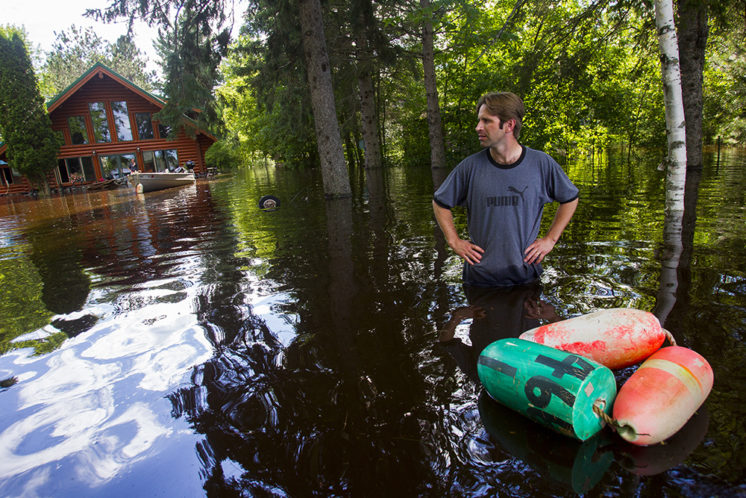
Joe Mohelsky looks around floodwaters that surrounded his home Thursday afternoon on the shore of Moosehead Lake June 21, 2012 in Moose Lake, Minn. The buoys in front of Mohelsky were placed at 9pm the previous night at the edge of floodwaters and by 5a.m., the waters had reached his house and continued to rise throughout the day.
The 2012 flood was a crazy time up here. I probably worked nearly two weeks straight as MPR dispatched two additional reporters to northern Minnesota in addition to local reporter Dan Kraker as we drove all over talking to people and documenting the damage. This was in the first hours of the flood as Moosehead Lake was flooding homes near the lake. The hard part was talking to many of these homeowners who did not have flood insurance because it was either too expensive for how little they believed they might need it or who just could not buy into the National Flood Insurance program because of where they lived.
I’d best describe my style as documentary. I came to Duluth after being hired as a photojournalist at the Duluth News Tribune and left there in 2009 and started my own business later that year. I think that style is reflected in wedding work I do, certainly in the ongoing work I do for MPR while the lighting and people skills acquired while at the DNT help when working with parents, leagues and kids for the team and individual photos I do.
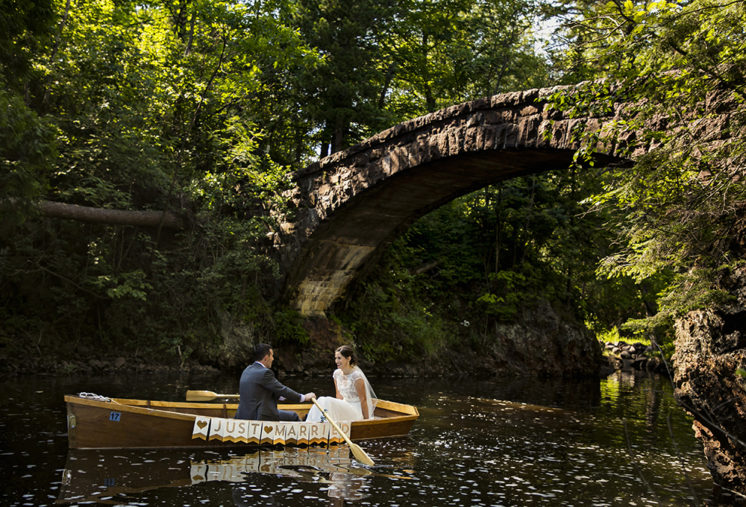
Wedding photography at the Glensheen Mansion
Bought waders for this shot and ventured into the creek to get this angle.
Are there differences in how you approach a wedding vs a photojournalism assignment?
A wedding requires so much more planning and time management. Not that I don’t plan or do research about what I’m photographing prior to an editorial assignment, but weddings are often in the planning phase for months and months before the big day and some weddings have events planned right down to the minute so it’s important to know what is happening, when it’s happening and then make sure you manage the timeline so that the bride, groom and wedding party gets great photos and gets to dinner on time. An editorial assignment also involves a lot of planning. You have to know the subject material of what you are photographing so you can capture visuals that communicate the story.
Additionally, with a wedding, you can shape the timeline to get the bride and groom in the best possible light for portraits. Most of the time with editorial subjects, you need to work with the time they give you and searching for best light is usually not an option. There might be amazing light outside, but if your story focuses on a peat production facility then you probably need to be shooting under the dim lights inside the production facility. You go where the subject exists while in wedding photography, the wedding photographer often has full control over where they can go.
One other big difference between wedding work and editorial work is the guidelines of what we can and cannot edit. Sometimes I can compensate for a terrible background or distracting objects in wedding photography by editing it in photoshop later. Maybe there is a really distracting sign or cigarette butts on the ground where the bride and groom are. It’s ok to remove those in photoshop for wedding work, but if I did that in my journalism work, I’d be immediately out of work. In editorial work, you have to live with things not always perfect because that is how the world is. Basically, editing in editorial work must preserve the integrity of the image’s context and content. One of my editors put it simply: don’t move pixels.
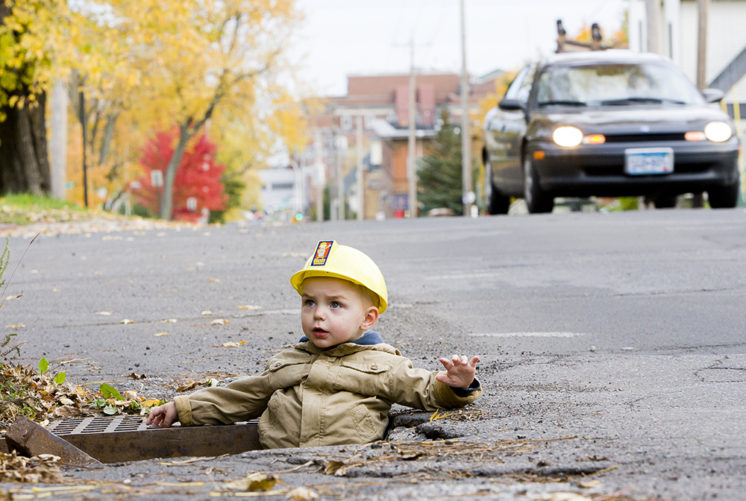
To dramatize how deep the hole is around a damaged sewer drain, three-foot tall Ryley Alexander McKeon stands inside a damaged section of 10th Avenue East and Sixth Street in Duluth, Minn. Ryley’s parents Tinita Olson and John McKeon say the damaged section of the street has been in a state of disrepair for at least the duration of the summer.
Derek Montgomery/Duluth News Tribune
Great backstory on this one. We were doing our annual pothole story at the DNT in 2008 and had put out a request to readers to send in locations of particularly horrendous potholes. The reporters compiled the information and sent me to a pothole on the corner of 10th Avenue East and Sixth Street to do a photo illustration on how deep it was. Upon arrival, I realized it was not your normal pothole. The portion of the street with the pothole had deteriorated so badly that the underlying soil washed away causing the pothole and an adjacent sewer drain to collapse. So the toaster that I was sent with to provide context about how big this pothole was wouldn’t work since the pothole was at least 20-inches deep. That’s when it popped into my head that maybe putting a kid in the pothole would better illustrate the subject. Don’t ask me about my mental processes here. There was a nearby park and as I was leaving to go down there, this kid and his parents came walking up the street. It was fate. Explained the story and asked the parents the weirdest question they would hear that day. “Can I put your kid in a pothole?” They agreed and had told me they had contacted the city about the pothole as they lived just up the road from it. So we put the kid in the pothole with the parents just off camera. There was no danger of the kid disappearing into the drain as the asphalt had completely blocked and filled in the sewer hole. The rest is history. It was not what the editors were expecting, but they ran it on the front page.
This is not how we usually document stories. Not the kid-in-a-pothole part, but we were clear that this was a photo illustration and I want to make that clear in this age of FAKE NEWS. As a photojournalist at the DNT, our staff would never instruct people what to do on an assignment. We are there to document the truth to the fullest extent possible. In this case, since it was a photo illustration, we have a little more leeway in terms of crafting the visual. To quote the Poynter Institute, a photo illustration is “a set-up photograph (usually in a studio with no digital alteration) that is illustrative in nature and is clearly out of the realm of reality.”
You offer the “Wild Booth” at events, has the interaction people have with photography or photographers changed with social media and phones?
It has. There is more pressure to post quickly. People want sneak peeks and they want to be able to access their images digitally. Wedding hashtags are more the norm these days, which is something we often include on the print designs of the Wild Booth. I also think that people can always be researching photographers now that more people are browsing Facebook and the Internet on a phone than a desktop. So you have to have a somewhat active Facebook/Instagram/online presence for people to find you and reach out.
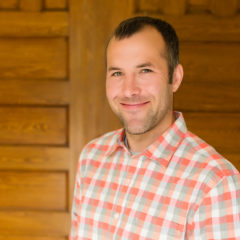 I absolutely love what I do, but there are certainly rewards and challenges. The rewards are meeting and working with so many amazing people. I love telling stories and getting to know people so my work for MPR is among the most favorite parts of my job. So many interesting people and stories going on and it’s perfect for someone like me who could ask 900 questions. I get to work from home during the summer, which means I can throw a frisbee or play baseball with my kids during the day or take a random day off to go up the shore or to a movie with them. That is a luxury that I will never take for granted.
I absolutely love what I do, but there are certainly rewards and challenges. The rewards are meeting and working with so many amazing people. I love telling stories and getting to know people so my work for MPR is among the most favorite parts of my job. So many interesting people and stories going on and it’s perfect for someone like me who could ask 900 questions. I get to work from home during the summer, which means I can throw a frisbee or play baseball with my kids during the day or take a random day off to go up the shore or to a movie with them. That is a luxury that I will never take for granted.
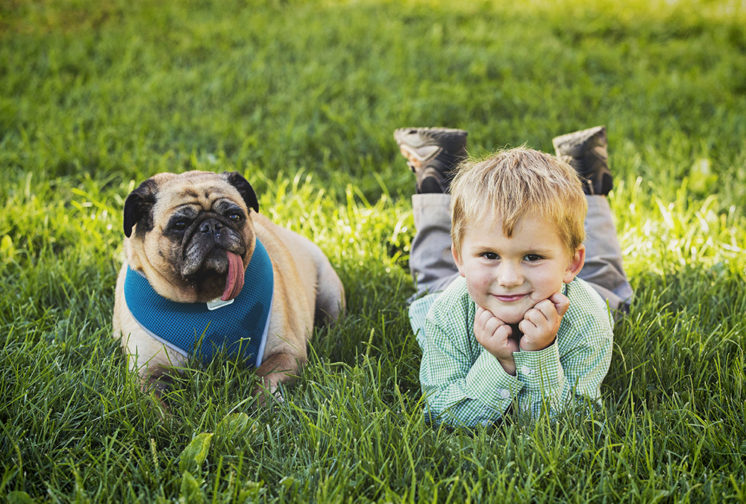
THIS DOG’S TONGUE. The tongue caught my eye early on during this wedding day and I had to capture an image of it at some point. Saw the kid laying next to the dog just poking the tongue with his finger so I got down on the ground, the kid looked over and the rest is history.
On the flip side, working from home with two kids and soon three kids can be a challenge when it comes to productivity. Those same kids you get to take fun places and hang out with don’t always see dad-in-front-of-a-computer as working so lots of interruptions are the norm. As a self-employed photographer, you are responsible for every aspect of your business–the picture taking, archiving, editing, social media, Quickbooks/tax work (this is actually the domain of my wife/CFO Kristin Montgomery but I know many don’t have an awesome financial-minded wife to handle things like this), driving to and from locations, meeting with clients, etc. etc. All of that together is a HUGE time commitment. So while I can randomly take a day or afternoon off, it just means all those things get piled up and as any self-employed photographer will tell you, there is always something else that needs to be done.
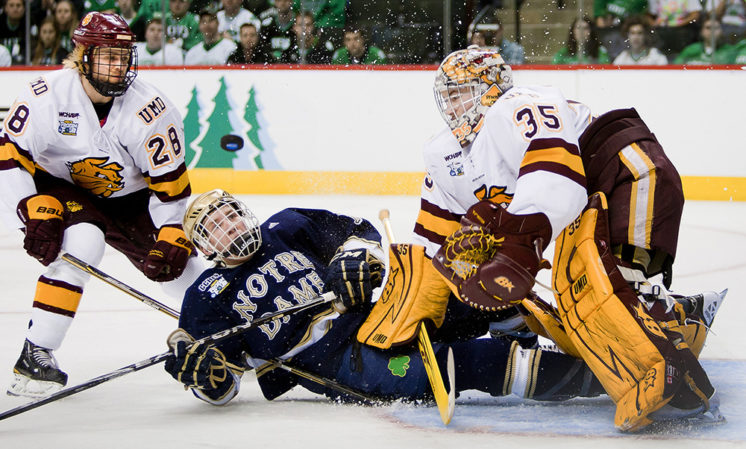
UMD goaltender Kenny Reiter (right) and Wade Bergman (left) watch a puck Reiter deflected sail over the head of Notre Dame’s David Gerths Thursday evening during an NCAA semifinal hockey game Friday, April 8, 2011 at the Xcel Energy Center in St. Paul, Minn.
Amazing energy at this game and fortunate bounce for the photographer and UMD.
I do not have any public galleries on display right now. You may have seen some of my work within MPR’s Faces of Minnesota photo exhibit, which traveled the state in 2017. The exhibit ended late last year, but there was some talk that it might return in some form so maybe keep an eye out on that. Otherwise, my website and social media accounts below are the best way to see what I’ve been up to.
Links:
My website is www.derekmontgomery.com
Instagram is instagram.com/photodrock
My Facebook page is facebook.com/derekmontgomeryphotography
I’ll be traveling to South Africa in January to document a week-in-the-life at Open Arms Home for Children. Open Arms Home for Children is a non-profit organization providing a home, education and security to children orphaned by the AIDS pandemic in South Africa. I’ve been working with the orphanage for a number of years and now have the opportunity to travel there and provide documentary work for the home as they continue to expand and help the AIDS orphans.
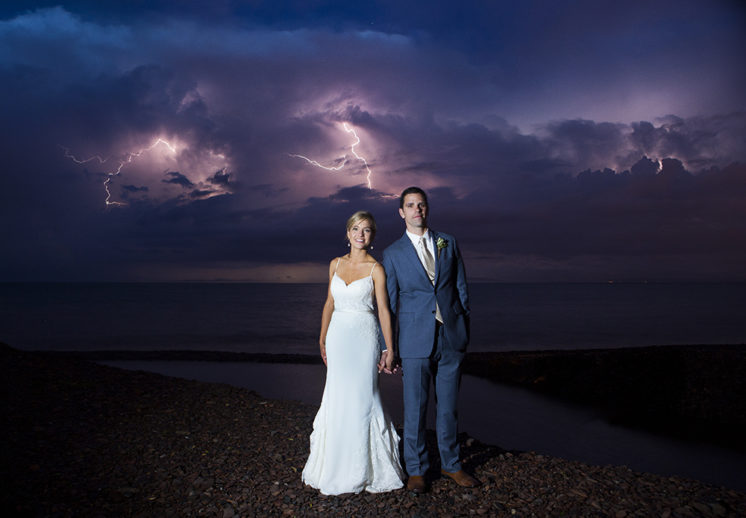
Wedding photography along the shore of Lake Superior with a thunderstorm across the lake over Wisconsin.
This was a 15-second exposure during one of those thunderstorms where the sky was constantly being illuminated with lightning. It was actually pretty clear in Duluth at the time and the front did not reach our location for awhile. The storm clouds you see in this photo were over portions of Wisconsin so we took advantage of the show.
Recommended Links:
Leave a Comment
Only registered members can post a comment , Login / Register Here



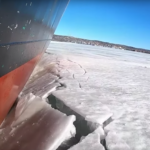











No Comments